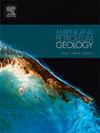Contrasting fracturing and cementation timings during shale gas accumulation and preservation: An example from the Wufeng-Longmaxi shales in the Fuling shale gas field, Sichuan Basin, China
IF 3.7
2区 地球科学
Q1 GEOSCIENCES, MULTIDISCIPLINARY
引用次数: 0
Abstract
The marine shales in southern China are characterized by high thermal evolution and intensive deformation during multistage burial and uplift. Fracturing and cementation, associated with tectonic activity, diagenesis, hydrocarbon generation and migration processes, are widely and variably distributed in shale reservoirs experiencing different tectonic evolution. In this study, we utilized cross-cutting relationships, fluid inclusion microthermometry, and laser Raman spectroscopy of fluid inclusions, along with U-Pb dating of fracture-filling calcite veins, integrated with burial history modeling, to elucidate the timing and mechanism of fracturing in the Paleozoic Wufeng-Longmaxi shale reservoir, as well as regional variations in the Fuling shale gas field. Bedding-parallel fractures (BFs) in shale reservoirs are filled with calcite and quartz veins. The timing of fracturing, as determined by minimum homogenization temperatures and U-Pb dating, is estimated to have occurred during ca. 191 -122 Ma, during which some short vertical (or high-angle) fractures (VFs) opened around 163.4 Ma and 137 Ma, subsequently sealed by calcite veins, respectively. All calcite and quartz veins within these fractures contain high-density methane inclusions, while shale reservoirs were in a high-over-mature evolutionary stage. This suggests that fracturing was primarily driven by gas generation overpressure during deep burial. In shale reservoirs near fault belt folds, multistage fractures developed, including three stages of intersecting fractures (IFs) and one-stage of long VFs. The timing of fracturing and cementation corresponds to the Yanshanian tectonic uplift (ca. 83 - 69 Ma) with intense tectonic movement likely being the direct cause of fracture opening. The presence of abundant gas inclusions in veins recorded shale gas expulsion during rapid tectonic uplift, reflecting the destruction of shale gas preservation conditions. In contrast, no significant fracturing or cementation processes have been observed in the tectonically gentle zones. The different fracturing and cementation processes indicated that preservation conditions declined with increased fracture openings during uplift, correlating with the gas enrichment.
页岩气聚集和保存过程中压裂和胶结时间的对比:以中国四川盆地涪陵页岩气田五峰-龙马溪页岩为例
中国南方海相页岩在多级埋藏和隆起过程中具有高热演化和强烈变形的特点。在经历不同构造演化的页岩储层中,与构造活动、成岩作用、油气生成和迁移过程相关的断裂和胶结分布广泛且差异较大。在这项研究中,我们利用横切关系、流体包裹体微测温、流体包裹体激光拉曼光谱以及裂缝充填方解石脉的铀-铅年代测定,结合埋藏史建模,阐明了古生代五峰-龙马溪页岩储层的压裂时间和机制,以及涪陵页岩气田的区域变化。页岩储层中的层理平行裂缝(BFs)充满了方解石和石英脉。根据最低均化温度和铀-铅年代测定,断裂时间估计发生在大约 191-122 Ma,期间一些短的垂直(或高角度)断裂(VFs)分别在 163.4 Ma 和 137 Ma 左右打开,随后分别被方解石脉封住。这些断裂内的方解石脉和石英脉均含有高密度甲烷包裹体,而页岩储层则处于高度超成熟演化阶段。这表明,在深埋过程中,断裂主要是由气体生成超压驱动的。在断层带褶皱附近的页岩储层中,发育了多级断裂,包括三级相交断裂(IF)和一级长VF。断裂和胶结的时间与燕山构造隆起(约 83 - 69 Ma)相吻合,强烈的构造运动可能是断裂打开的直接原因。岩脉中大量气体包裹体的存在记录了页岩气在快速构造隆升过程中的排出,反映了页岩气保存条件的破坏。与此相反,在构造平缓带没有观察到明显的断裂或胶结过程。不同的断裂和胶结过程表明,在隆起过程中,保存条件随着断裂开口的增加而下降,这与气体富集相关。
本文章由计算机程序翻译,如有差异,请以英文原文为准。
求助全文
约1分钟内获得全文
求助全文
来源期刊

Marine and Petroleum Geology
地学-地球科学综合
CiteScore
8.80
自引率
14.30%
发文量
475
审稿时长
63 days
期刊介绍:
Marine and Petroleum Geology is the pre-eminent international forum for the exchange of multidisciplinary concepts, interpretations and techniques for all concerned with marine and petroleum geology in industry, government and academia. Rapid bimonthly publication allows early communications of papers or short communications to the geoscience community.
Marine and Petroleum Geology is essential reading for geologists, geophysicists and explorationists in industry, government and academia working in the following areas: marine geology; basin analysis and evaluation; organic geochemistry; reserve/resource estimation; seismic stratigraphy; thermal models of basic evolution; sedimentary geology; continental margins; geophysical interpretation; structural geology/tectonics; formation evaluation techniques; well logging.
 求助内容:
求助内容: 应助结果提醒方式:
应助结果提醒方式:


